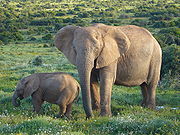
Seismic communication
Encyclopedia

Seismology
Seismology is the scientific study of earthquakes and the propagation of elastic waves through the Earth or through other planet-like bodies. The field also includes studies of earthquake effects, such as tsunamis as well as diverse seismic sources such as volcanic, tectonic, oceanic,...
vibrations of the earth. Seismic cues are generated through percussion on the earth substrate or acoustical waves that couple with the earth, called rayleigh waves.
Overview

Though recently, many studies have indicated intentional use of ground vibrations
Ground vibrations
Ground vibrations is a technical term that is being used to describe mostly man-made vibrations of the ground, in contrast to natural vibrations of the Earth studied by seismology. For example, vibrations caused by explosions, construction works, railway and road transport, etc - all belong to...
as a means of communication among the Cape mole rat and the Asian elephant.
Airborne sound waves spread spherically rather than cylindrically, attenuating more rapidly (losing 6 dB for every doubling of distance) than ground surface waves such as Rayleigh waves (3 dB loss for every doubling of distance), and thus these ground surface waves maintain integrity longer.
In elephants
Pioneering research in elephant infrasound communication was done by Katy Payne, of the Elephant Listening Project, and is detailed in her book Silent Thunder. Though this research is still in its infancy, it is helping to solve many mysteries, such as how elephants can find distant potential mates, and how social groups are able to coordinate their movements over extensive range. Joyce Poole has also begun decoding elephant utterances that have been recorded over many years of observation, hoping to create a lexicon based on a systematic catalogue of elephant sounds.In the late 90's, Caitlin O'Connell-Rodwell first argued that elephants communicate over long distances using low-pitched sounds that are barely audible to humans.
Her insights generated international media attention after the 2004 Boxing day tsunami in Asia, following reports that trained elephants in Thailand had become agitated and fled to higher ground before the devastating wave struck, thus saving their own lives and those of the tourists riding on their backs. Because earthquakes and tsunamis generate low-frequency waves, O'Connell-Rodwell and other elephant experts have begun to explore the possibility that the Thai elephants were responding to these events.
Seismic energy transmits most efficiently between the 10 and 40 Hz - in the same range as the fundamental frequency and 2nd harmonic of an elephant rumble. It seems that when an elephant rumbles a replica of the airborne sound is also transmitted through the ground.
Thus, African Bush Elephant
African Bush Elephant
The African Bush Elephant or African Savanna Elephant is the larger of the two species of African elephant. Both it and the African Forest Elephant have usually been classified as a single species, known simply as the African Elephant...
s are able to use seismic
Seismology
Seismology is the scientific study of earthquakes and the propagation of elastic waves through the Earth or through other planet-like bodies. The field also includes studies of earthquake effects, such as tsunamis as well as diverse seismic sources such as volcanic, tectonic, oceanic,...
vibrations at infrasound
Infrasound
Infrasound is sound that is lower in frequency than 20 Hz or cycles per second, the "normal" limit of human hearing. Hearing becomes gradually less sensitive as frequency decreases, so for humans to perceive infrasound, the sound pressure must be sufficiently high...
frequencies for communication.
These calls range in frequency from 15–35 Hz and can be as loud as 117 dB, allowing communication for many kilometres, with a possible maximum range of around 10 km. This sound can be felt by the sensitive skin of an elephant's feet and trunk, which pick up the resonant vibrations much as the flat skin on the head of a drum. To listen attentively, every member of the herd will lift one foreleg from the ground, and face the source of the sound, or often lay its trunk on the ground. The lifting presumably increases the ground contact and sensitivity of the remaining legs. This ability is thought also to aid their navigation by use of external sources of infrasound.
The waves, or vibrations, travel up the leg bone of another elephant, through the shoulder and to the middle ear bones, where they are processed in the auditory cortex region of the brain.
Research
- Rado, R., Himelfarb, M., Baruch ArensburgBaruch ArensburgBaruch Arensburg , professor of Anatomy, Sackler School of Medicine, Tel-Aviv University , is a physical anthropologist whose main field of study has been prehistoric and historic populations of the Levant....
, Terkel, J. and Wollberg, Z. 1989 Are seismic communication signals transmitted by bone conduction in the blind mole rat? Hearing Research 41: 23 - 30. - O'Connell-Rodwell and animal curator Colleen Kinzley have also been studying elephant vibrations.http://www.utopiascientific.org/

